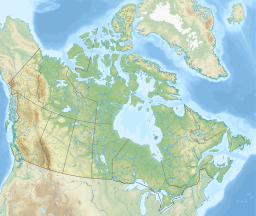geo.wikisort.org - Reservoir
Manitou Lake is a salt-water lake located mostly in the RM of Manitou Lake No. 422 in the Canadian province of Saskatchewan, about 10 kilometres away from the provincial border with Alberta. The eastern shore of the lake is in the RM of Hillsdale No. 440. Manitou Lake is located in a region called the Prairie Pothole Region of North America, which extends throughout three Canadian provinces and five U.S. states. It is also within Palliser's Triangle and the Great Plains ecoregion.
| Manitou Lake | |
|---|---|
 North-West Bay | |
| Location | Manitou Lake No. 442, Saskatchewan |
| Coordinates | 52°43′N 109°43′W |
| Type | Endorheic |
| Primary inflows | Eyehill Creek |
| Catchment area | 3,000 km2 (1,200 sq mi) |
| Basin countries | Canada |
| Surface area | 78 km2 (30 sq mi) |
| Islands | Manitou Island |
| Settlements | Marsden, Neilburg |
| References | [1][2][3] |
Because the lake is an endorheic lake and quite salty, there are no fish in the lake. Manitou Island in the centre of the lake is now connected to the southern shore as the water level has lowered.
Description
The primary inflow for the lake is from Eyehill Creek[4] at the south end. There are also many small springtime meltwater tributaries that feed the lake. Eyehill Creek originates in neighbouring Alberta from Sounding Lake, which in turn is fed by Sounding Creek. Manitou Lake and its tributaries are part of a closed basin watershed. When the lake level rises high enough, it overflows to the north through Wells Lake near Marsden and then into Battle River, which is a tributary of the North Saskatchewan River. This has only happened once since European settlers first arrived in the area, and that was in approximately 1905.
Lake levels were relatively constant until 1980, and have been declining rapidly since then by approximately one metre every six years. Less annual snowfall and heavier utilisation of water from the Eyehill Creek system by urban, industrial, and agricultural users is blamed for this trend.
Along the southern shore of the lake are the Manitou Sand Hills. The hills total 105,000 acres of Crown grazing land set aside by the Saskatchewan government.[5]
There are no communities on the lake's shore. The nearest communities are Marsden, about 4 miles north of the north-west corner of the lake in the RM of Manitou Lake, and Neilburg, about 4 miles north of the north-east corner of the lake in the RM of Hillsdale, along Highway 40. At the lake's North-West Bay, there is Big Manitou Regional Park.[6] Originally founded as part of Suffern Lake Regional Park[7] in 1975, it became its own indepenant Regional Park in 2019. The park features camping, cabins, picnicking, swimming, and the Manitou Lake Golf Club. Just to the east of the regional park, is Manitou Lake Bible Camp.
See also
- List of lakes of Saskatchewan
- Salt lake
References
- "Natural Resources Canada-Canadian Geographical Names (Manitou Lake)". Retrieved 6 February 2015.
- "Atlas of Canada Toporama". Retrieved 6 February 2015.
- "IBA Canada (Community Conservation Plan for the Manitou Lake Important Bird Area)" (PDF). 2001. Archived from the original (PDF) on 6 February 2015. Retrieved 6 February 2015.
- Government of Canada, Natural Resources Canada. "Place names - Eyehill Creek". www4.rncan.gc.ca.
- "MINISTERS RELEASE MANITOU SAND HILLS INTEGRATED LAND USE PLAN | News and Media".
- "Big Manitou".
- Government of Canada, Natural Resources Canada. "Place names - Suffern Lake Regional Park (Manitou Section)". www4.rncan.gc.ca.
Другой контент может иметь иную лицензию. Перед использованием материалов сайта WikiSort.org внимательно изучите правила лицензирования конкретных элементов наполнения сайта.
WikiSort.org - проект по пересортировке и дополнению контента Википедии

